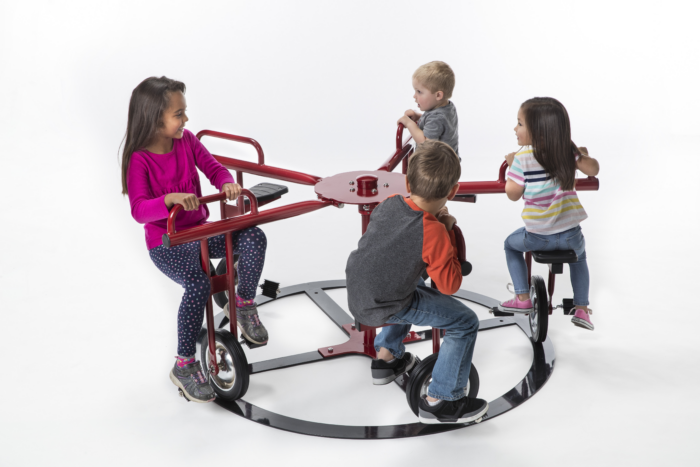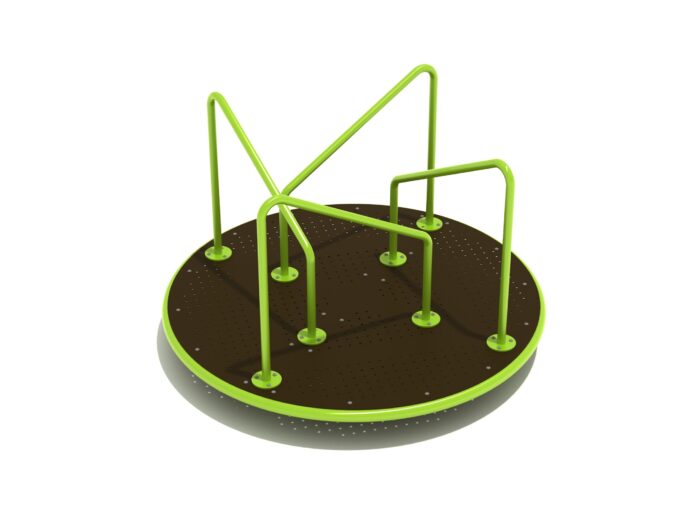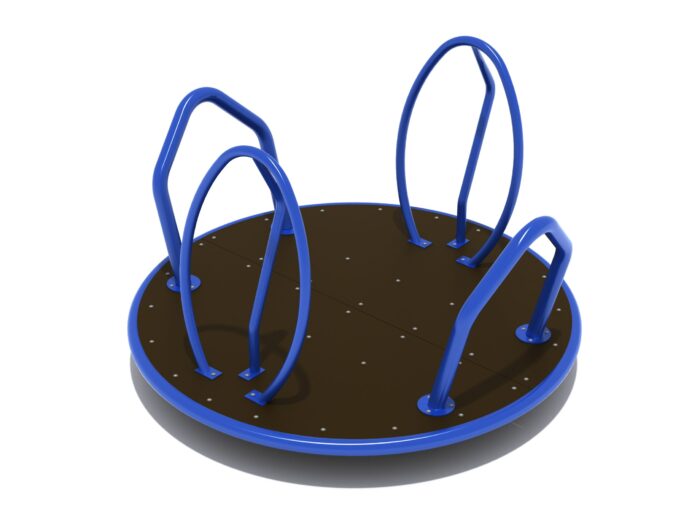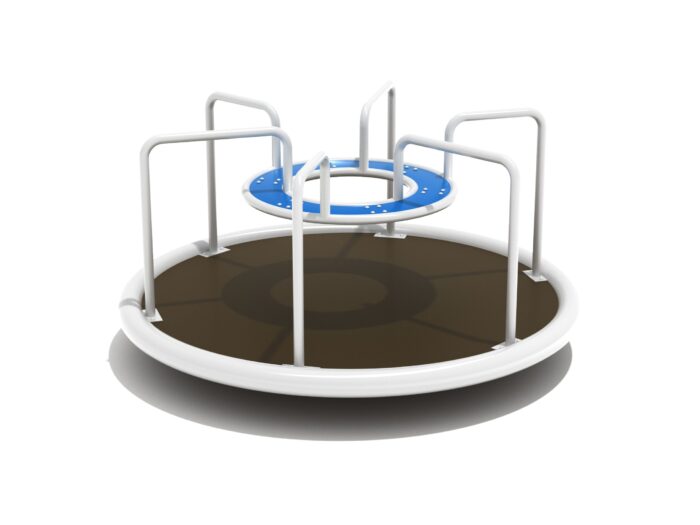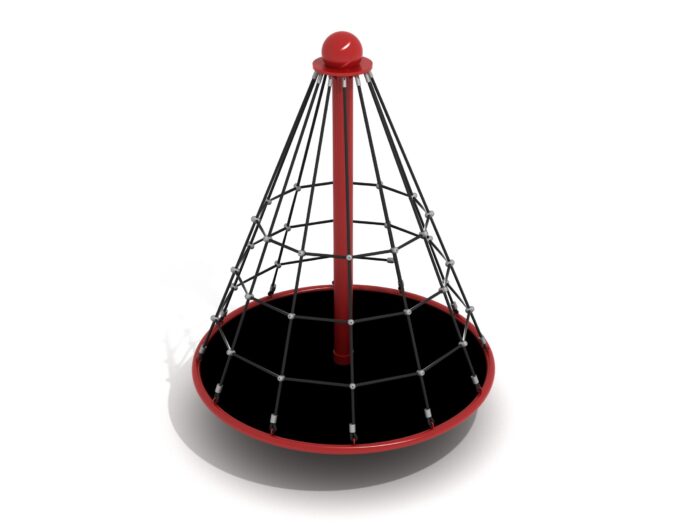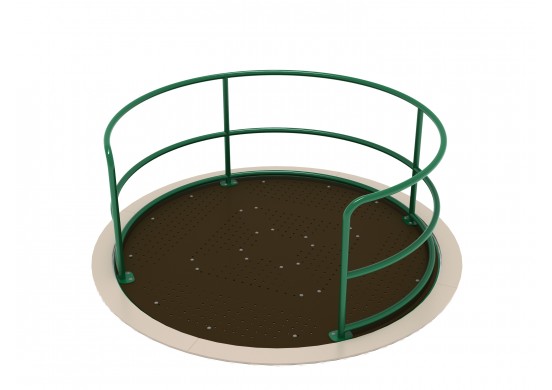Your cart is currently empty!
Merry-Go-Rounds
- All Products
- Climbers
- Components
- Free Standing Play
- Merry-Go-Rounds
- Rope Net Climbers
- Spinning
Showing all 6 results
-
5-Seat Merry Go Cycle
$2,452.00 -
Radical Rotator
$3,194.30 -
Galaxy Disc
$3,638.00 -
Kings Carousel
$3,831.80 -
Mauritius
$6,050.30 -
One Capacity Wheelchair Accessible Merry Go Round
$14,069.50
Playground Merry-Go-Rounds
In the field of playground equipment, merry-go-rounds stand out as a centrifugal force of fun, spinning generations of children into laughter and dizzy spells. Yet, the spinning motion is not all there is; behind every whirl lies a complex interplay of design principles, safety standards, and material science.
We’ll embark on a detailed exploration of playground merry-go-rounds, dissecting their design for safety, the choice of materials for durability, considerations for age-appropriate enjoyment, and the emerging trends that are shaping their future. We’ll also discuss the maintenance practices crucial for preserving their charm and longevity. Through this comprehensive lens, we aim to equip stakeholders with the knowledge to craft merry-go-rounds that are not only sources of endless fun but are also safe, inclusive, and sustainable.
What is a playground merry-go-round?
A playground merry-go-round, often simply termed a merry-go-round, is a revolving piece of playground equipment that children can ride on. It operates on the principle of centrifugal force, enabling it to spin around a central axis. Typically, these structures are designed to accommodate multiple riders at once, offering handholds and seating areas for children to grasp and sit on during the ride.
The essence of a merry-go-round lies in its ability to provide a shared, dynamic play experience, fostering both physical coordination and social interaction among its users. This equipment, while offering endless fun, also incorporates intricate design and safety considerations to ensure a secure play environment for children of various ages.
What are current trends in merry-go-round design?
Current trends in merry-go-round design are increasingly focusing on inclusive design, ensuring accessibility for children of all abilities. ADA-compliant designs are becoming standard, featuring elements like wheelchair ramps and low-to-the-ground platforms. Additionally, there’s a growing emphasis on sensory-friendly features that cater to children with sensory processing disorders, incorporating elements that stimulate without overwhelming. Technological integration is another rising trend, with designs incorporating interactive light and sound elements that enhance the play experience. Furthermore, the use of renewable energy sources to power these interactive features reflects a commitment to sustainability. These trends not only make merry-go-rounds more enjoyable and accessible but also ensure they contribute positively to the development of all children and the environment.
Inclusive Design Trends
| Trend | Description | Examples |
| ADA-compliant Designs | Incorporating features like wheelchair ramps and low platforms to ensure accessibility for all children. | “Freedom Spinner” in Liberty Park, USA, offers wheelchair-accessible entry and seating. |
| Sensory-friendly Features | Designing with elements that cater to children with sensory processing disorders, such as varied textures and quiet play areas. | “Sensory Circle” in Sensory Park, UK, uses soft sounds and gentle movements to engage without overwhelming. |
Technological Integration
| Feature | Purpose | Examples |
| Interactive Light and Sound Elements | Enhancing play experience with responsive light and sound that encourage imaginative play. | “IllumiPlay Roundabout” in TechTown Playground, Germany, features LED lights and sound effects triggered by motion. |
| Renewable Energy Sources | Using solar panels or kinetic energy from play to power interactive features, promoting sustainability. | “Solar Spin” in GreenPlay Park, Australia, uses solar panels to power its light and sound features. |
How does age-appropriate design affect construction?
Age-appropriate design significantly influences the construction of merry-go-rounds, ensuring they cater to the developmental needs and safety requirements of different age groups. For toddlers, features include lower heights and slower speeds, enhancing safety and accessibility. For older children, designs incorporate higher platforms and faster spinning capabilities, challenging their physical abilities while maintaining safety. The incorporation of adjustments for height and reach and speed control mechanisms is crucial, allowing for a tailored play experience that is both safe and engaging. This approach not only impacts the choice of materials and safety features but also dictates the overall structure and functionality of the merry-go-round, ensuring a fun, inclusive, and safe environment for all users.
Designs for Different Age Groups
| Age Group | Design Features | Safety Considerations | Interactive Elements |
| Toddlers (0-2 years) | Low-to-ground platforms, Gentle spinning mechanisms | Soft flooring materials, Guardrails and handholds | Vibrant colors, Simple shapes |
| Preschool (3-5 years) | Moderate heights, Moderate spinning speeds | Impact-absorbing surfaces, Secure seating | Interactive panels, Sound elements |
| School Age (6-12 years) | Higher platforms, Faster spinning capabilities | Speed control mechanisms, Enhanced grip features | Complex shapes, Themed designs |
Designs for merry-go-rounds are thoughtfully tailored to meet the diverse needs of various age groups, ensuring that each structure is both engaging and safe. For the youngest users, simplicity and safety are prioritized, while designs for older children incorporate more complex features to challenge their abilities and encourage growth.
Toddler-friendly Features
Toddler-friendly features on merry-go-rounds include low-to-ground platforms for ease of access, gentle spinning mechanisms to prevent dizziness, and vibrant colors to stimulate sensory development. These elements make merry-go-rounds accessible and enjoyable for toddlers, fostering their early engagement with physical activities in a safe manner.
Features for Older Children
For older children, merry-go-rounds are designed with faster speeds, higher platforms, and interactive elements that demand greater physical strength and coordination. These features respond to older children’s craving for challenge and adventure, promoting their physical development within a safe, controlled environment.
Impact on Safety and Usability
The incorporation of age-appropriate features significantly impacts both the safety and usability of merry-go-rounds. By designing with the developmental stages of children in mind, the risk of accidents is minimized, ensuring that the equipment remains fun and functional for users of all ages.
Adjustments for Height and Reach
Incorporating adjustments for height and reach is crucial for making merry-go-rounds accessible to children of various sizes and developmental stages. These adjustments guarantee that all children can engage with the equipment safely and comfortably, enhancing the inclusivity of playgrounds.
Speed Control Mechanisms
Speed control mechanisms play a vital role in the safety of merry-go-rounds, particularly for younger users. By allowing for the adjustment of the spinning speed to match the age and abilities of the children, these mechanisms ensure a safe and enjoyable play experience for every user.
Why is safety critical in merry-go-round design?
Safety is paramount in merry-go-round design due to the dynamic nature of its operation, which involves spinning motion that can pose risks if not properly managed. Ensuring safety mitigates the potential for accidents and injuries, allowing children to enjoy the thrill of the ride without harm. This involves incorporating safety features such as soft flooring materials to cushion falls, guardrails and handholds for stability, and adhering to common safety standards, including ASTM standards for playground equipment and CPSC guidelines for public playground safety. By prioritizing safety, designers create an environment where children can engage in playful exploration with peace of mind for parents and caregivers.
Types of Safety Features
Safety features in merry-go-round design are critical for preventing accidents. These include impact-absorbing surfaces, speed limiters, and lockable access gates to ensure the merry-go-round is used under appropriate supervision, enhancing the overall safety of the play environment.
Soft Flooring Materials
Soft flooring materials like rubber mulch, poured-in-place rubber, and engineered wood fiber play a pivotal role in cushioning falls. They are essential for minimizing the risk of injury, providing a safer landing for children in case of slips or falls from the merry-go-round.
Guardrails and Handholds
The inclusion of guardrails and handholds offers necessary stability and support, making it easier for children to maintain their grip and balance during the merry-go-round’s rotation. These features are designed to be both child-friendly and robust, significantly reducing the likelihood of falls.
Common Safety Standards
Compliance with common safety standards is non-negotiable, ensuring that merry-go-rounds are constructed and maintained to meet essential safety criteria. These standards address various aspects, including material durability, structural stability, and the elimination of potential hazards like pinch points or sharp edges.
ASTM Standards for Playground Equipment
The ASTM standards for playground equipment, particularly ASTM F1487, set forth rigorous safety specifications for public play equipment. These standards are integral for minimizing risks associated with moving parts, entrapment hazards, and safe egress from the equipment, ensuring a safer play space for children.
CPSC Guidelines for Public Playground Safety
The CPSC guidelines for public playground safety offer a comprehensive framework for the safe design and operation of playgrounds, including merry-go-rounds. Emphasizing proper installation, diligent maintenance, and vigilant supervision, these guidelines aim to foster a secure and enjoyable playground experience for every child.
Safety Standards in Action: A Case Study
A notable example of the impact of adhering to safety standards is the renovation of Central Park’s Adventure Playground merry-go-round. Prior to the renovation, the playground had experienced several minor incidents due to outdated equipment and insufficient safety features. The renovation project included the installation of new, ASTM-compliant merry-go-rounds equipped with modern safety features such as impact-absorbing flooring and secure handholds. Since the renovation, there have been no reported accidents related to the merry-go-round, demonstrating the effectiveness of adhering to established safety standards in preventing injuries and ensuring a safe play environment.
This case study underscores the importance of following safety guidelines and standards in merry-go-round design and installation. By prioritizing safety and adhering to recognized standards, playgrounds can provide a secure and enjoyable experience for all users, minimizing risks and fostering a safe space for play and exploration.
What materials are used in merry-go-round construction?
The construction of merry-go-rounds utilizes a variety of materials, each chosen for its durability, safety implications, and ability to withstand the rigors of outdoor environments. Metal, plastic, and wood are the most common materials, each offering unique benefits. Metal is prized for its strength and longevity, plastic for its resistance to corrosion and vibrant colors, and wood for its natural aesthetics and tactile warmth. Additionally, non-toxic coatings and treatments are applied to these materials to enhance safety and durability, ensuring that the merry-go-rounds are safe for children and resistant to wear and environmental factors. This careful selection of materials and treatments is essential for creating merry-go-rounds that are not only enjoyable but also safe and long-lasting.
Durability of Materials
The durability of materials is paramount in ensuring the longevity and ongoing safety of merry-go-rounds. These materials must endure constant usage, adverse weather conditions, and the passage of time, maintaining their integrity to provide a secure playground environment for children.
Comparison: Metal vs. Plastic vs. Wood
| Material | Durability | Maintenance | Safety Implications | Aesthetic | Environmental Impact |
| Metal | High | Low | Can get hot; requires coatings for safety | Industrial | Recyclable, but high energy for production |
| Plastic | Moderate | Very Low | Resistant to corrosion; softer edges | Colorful | Non-biodegradable; some are recyclable |
| Wood | Moderate to High | High | Requires treatment to prevent splinters and decay | Natural | Sustainable if sourced responsibly |
In the comparison between metal, plastic, and wood, each material offers distinct advantages and challenges. Metal stands out for its exceptional durability and structural integrity, making it a long-lasting choice. Plastic is favored for its low maintenance and resistance to corrosion, offering a colorful and versatile option. Wood brings a natural aesthetic to playgrounds but requires more maintenance to prevent decay and withstand the elements. Selecting the right material involves balancing durability, maintenance, and aesthetic considerations.
Safety Implications of Materials
The safety implications of materials used in merry-go-round construction are critical. It’s essential that these materials do not pose hazards such as sharp edges, splinters, or toxic substances. Beyond being safe to the touch, materials must also be structurally sound to handle the dynamic forces of play without risk of failure.
Non-toxic Coatings and Treatments
Non-toxic coatings and treatments play a vital role in both enhancing the safety and extending the life of playground materials. These protective measures guard against environmental damage such as rust and decay, while ensuring the surfaces remain safe for children’s contact. Employing such treatments not only preserves the equipment’s structural integrity but also supports a healthier play environment.
How is maintenance integral to merry-go-round longevity?
Regular maintenance is crucial for extending the life of merry-go-rounds and ensuring their ongoing safety and functionality. This includes routine inspections to identify and address wear and tear, cleaning protocols to keep the equipment hygienic and free from hazardous substances, and repair tasks to fix any damages promptly. Such diligent maintenance practices not only prevent the premature deterioration of the equipment but also safeguard the well-being of its users. By prioritizing maintenance, stakeholders can ensure that merry-go-rounds remain vibrant, safe, and enjoyable spaces for children for years to come.
Regular Maintenance Tasks
| Task | Frequency | Details |
| Lubrication | Monthly | Apply lubricant to moving parts to ensure smooth operation. |
| Bolt Tightening | Monthly | Check and tighten bolts and nuts to prevent loosening due to vibration. |
| Structural Integrity Check | Quarterly | Inspect for cracks, rust, and other signs of wear that could compromise safety. |
Inspection Schedules
| Inspection Type | Frequency | Focus Areas |
| Visual Inspection | Daily | Quick check for obvious hazards such as debris, vandalism, or broken parts. |
| Operational Inspection | Weekly | Test the merry-go-round’s movement, speed control mechanisms, and safety features for proper function. |
| Comprehensive Inspection | Annually | Conduct a thorough examination of all components, including underground supports and internal mechanisms. |
Cleaning and Repair Protocols
| Protocol | Frequency | Procedure |
| Cleaning | Weekly | Clean surfaces to remove dirt, debris, and potential contaminants. Use non-toxic cleaners safe for children. |
| Minor Repairs | As needed | Address minor issues such as replacing worn handholds or patching surface rust immediately upon detection. |
| Major Repairs | As needed | For significant damages or wear, such as structural repairs, consult with the manufacturer or a professional repair service. |
Case Study: Sunshine Park Merry-Go-Round
Sunshine Park’s merry-go-round underwent a comprehensive maintenance overhaul after routine inspections revealed significant wear on its central bearing system. The early detection allowed for repairs before the busy summer season, preventing potential safety hazards. This proactive approach underscored the importance of regular maintenance in ensuring the equipment’s longevity and safety. Post-repair, the merry-go-round continued to provide joy to the community, with no reported incidents or downtime, highlighting the effectiveness of diligent maintenance practices.
Impact of Maintenance on Safety
Regular maintenance significantly impacts the overall safety of merry-go-rounds. By keeping the equipment in optimal condition, maintenance practices help prevent accidents and ensure a safe play environment. The Sunshine Park case study exemplifies how routine inspections and timely repairs can mitigate risks, ensuring that merry-go-rounds remain a source of safe, enjoyable play for children.
What considerations are made for merry-go-round construction?
When constructing merry-go-rounds, several key considerations ensure their success and sustainability. Environmental impact is a major factor, guiding the selection of sustainable materials and energy-efficient manufacturing processes. The choice of materials not only affects the durability and safety of the merry-go-round but also its environmental footprint. Cost-effectiveness is balanced with long-term durability, aiming to provide value while minimizing the need for frequent replacements or repairs. Additionally, considerations around grants and funding can influence design choices, especially for public playgrounds, ensuring that projects are financially viable. These considerations are crucial for creating merry-go-rounds that are safe, enjoyable, and sustainable for communities.
Environmental Impact
The environmental impact of merry-go-round construction is a primary consideration, emphasizing the need for eco-friendly materials and practices. This approach aims to minimize the carbon footprint and ensure that playgrounds contribute positively to environmental sustainability.
Sustainable Materials
Choosing sustainable materials is key, focusing on those that are either recycled or sustainably sourced. Materials like recycled plastics and sustainably harvested wood not only support eco-friendly construction but also uphold safety and durability standards.
Energy-efficient Manufacturing Processes
Adopting energy-efficient manufacturing processes is essential for reducing energy consumption and greenhouse gas emissions. This includes leveraging renewable energy sources and implementing energy-saving technologies in manufacturing, aligning with sustainability goals.
Cost-effectiveness
Cost-effectiveness is a critical aspect of merry-go-round construction, aiming to deliver high-quality, durable playground equipment within budgetary limits. This involves a strategic balance between the upfront costs and the long-term benefits of durable, low-maintenance materials.
Long-term Durability vs. Initial Cost
Evaluating long-term durability against initial cost presents a significant consideration. Investing in superior materials and construction techniques might increase initial costs but can result in lower maintenance expenses and a longer lifespan, offering greater value over time.
Grants and Funding for Public Playgrounds
Grants and funding are vital for facilitating the construction of merry-go-rounds in public playgrounds. These financial supports can help offset the costs associated with sustainable and inclusive playground equipment, making it more accessible to communities.

